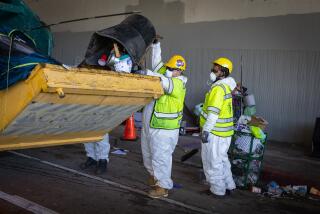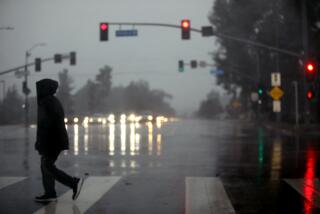Op-Ed: Preparing to declare a ‘local emergency’ could save L.A.’s homeless people when El Niño rains hit
I represented my first homeless client in 1983. She was living in an old Chevy while she tried, for six weeks, to get help from the county. At least in the old car, she told me, she didn’t need to worry about rainstorms. Even in the relatively mild L.A. winter, getting wet can be fatal if you have no place to get dry, get warm and recuperate.
I’ve been thinking of that client’s story in recent weeks. Today, unprecedented numbers of people are living in makeshift shelters on our streets, and meteorologists are predicting the strongest El Niño event in history. If Mayor Eric Garcetti — and the mayors of other local cities and the Los Angeles County Board of Supervisors — don’t prepare to declare a “local emergency,” many may die.
Even in the relatively mild L.A. winter, getting wet can be fatal if you have no place to get dry, get warm and recuperate.
Declaring a local emergency in Los Angeles is a legal act with specific consequences. Under city codes, it means an “occurrence which by reason of its magnitude is or is likely to become beyond the control of the normal services, personnel, equipment and facilities of the regularly constituted branches and departments of the city government.”
One could argue that we have been experiencing a local emergency for a long time. As counted in January, Los Angeles has the largest number of unsheltered homeless people — those not housed in any public or private facility — in America. Nearly 18,000 people — 69% of the homeless people in our city — lack shelter of any kind. This is far more than in New York (5%), Chicago (30%) or Houston (36%). About 70% are sleeping on sidewalks or in alleys, nearly half of them for the first time in their lives.
If Garcetti made an emergency declaration and the City Council ratified it, he could issue directives that he “considers necessary for the protection of life and property.” These take effect immediately, without delays for deliberations. He could “obtain vital supplies and other such property as is needed” and “requisition necessary personnel or material of any city department or agency.”
The mayor could open unused city buildings or enter into short-term leases for private buildings to provide shelter for the homeless to sleep and keep some of their belongings. The winter shelter programs that exist provide only a few hours of nighttime protection before people are forced back onto the streets. To make use of even this minimal shelter, homeless people have to leave behind everything they can’t carry, including pets that many have with them.
Simultaneously, the mayor could help people stay alive in the shelters they have made for themselves. It will be crucial for people to be able to get their few pieces of cardboard or a blanket off the ground, where rainwater could seep in. City agencies could provide pallets or other means of getting them off the ground, and tents and tarps that do not leak in a heavy storm.
A declaration of local emergency also gives the mayor some power to intercede directly with the Police Department, which otherwise reports only to the Police Commission. Last week, the City Council decided to make it a crime for a homeless person to refuse to break down a tent on a sidewalk at 6 a.m., or to put the same tent up before 9 p.m., even in a pouring rain. If a federal judge does not block that rule, the mayor could.
In general, with these powers, the mayor and city could try to deal more compassionately with street encampments when people have no other place to go. These are strewn with trash, in part because there is no trash pickup or even trash cans available. These sites are often far from any unlocked bathroom. The least the city could do is provide toilets and trash collection, and perhaps portable shower trailers.
Los Angeles spends $13 million per year — about one penny per day per resident — on services to help homeless people. In a local emergency, the mayor can simply requisition essential materials and commit the city to paying for them later. That might require raising the city’s contribution to two cents per day per resident — but no additional state or federal dollars.
If that’s not enough, the city has set aside $405 million in a reserve fund — what most people call a “rainy day” fund. Surely, some of that money can be used to save lives during the many actual rainy days to come. After 32 years of advocacy and research on homelessness in Los Angeles, I never thought I would be advocating for so little. Shame on us all.
Gary Blasi, professor of law emeritus at UCLA, is special counsel with Public Counsel’s Opportunity Under Law initiative.
Follow the Opinion section on Twitter @latimesopinion and Facebook
More to Read
A cure for the common opinion
Get thought-provoking perspectives with our weekly newsletter.
You may occasionally receive promotional content from the Los Angeles Times.






